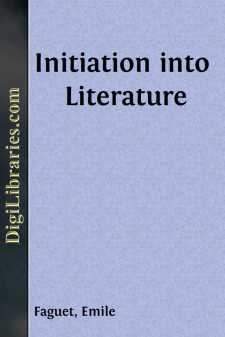Categories
- Antiques & Collectibles 13
- Architecture 36
- Art 48
- Bibles 22
- Biography & Autobiography 813
- Body, Mind & Spirit 142
- Business & Economics 28
- Children's Books 17
- Children's Fiction 14
- Computers 4
- Cooking 94
- Crafts & Hobbies 4
- Drama 346
- Education 46
- Family & Relationships 57
- Fiction 11829
- Games 19
- Gardening 17
- Health & Fitness 34
- History 1377
- House & Home 1
- Humor 147
- Juvenile Fiction 1873
- Juvenile Nonfiction 202
- Language Arts & Disciplines 88
- Law 16
- Literary Collections 686
- Literary Criticism 179
- Mathematics 13
- Medical 41
- Music 40
- Nature 179
- Non-Classifiable 1768
- Performing Arts 7
- Periodicals 1453
- Philosophy 64
- Photography 2
- Poetry 896
- Political Science 203
- Psychology 42
- Reference 154
- Religion 513
- Science 126
- Self-Help 84
- Social Science 81
- Sports & Recreation 34
- Study Aids 3
- Technology & Engineering 59
- Transportation 23
- Travel 463
- True Crime 29
Initiation into Literature
by: Emile Faguet
Description:
Excerpt
CHAPTER I
ANCIENT INDIA
The Vedas. Buddhist Literature. Great Epic Poems, then very
Diverse, much Shorter Poems. Dramatic Literature. Moral Literature.
THE VEDAS.—The ancient Indians, who spoke Sanscrit, possess a literature which goes back, perhaps, to the fifteenth century before Christ. At first, like all other races, they possessed a sacred literature intimately bound up with their religion. The earliest volumes of sacred literature are the Vedas. They describe and glorify the gods then worshipped, to wit, Agni, god of fire, of the domestic hearth, of the celestial fire (the sun), of the atmospheric fire (lightning); Indra, god of atmosphere, analogous to Zeus of the Greeks; Soma, the moon; Varuna, the nocturnal vault, the god who rewards the good and punishes the evil; Rudra, the irascible god, more evil than well disposed, though sometimes helpful; others too, very numerous.
The style of the Vedas is continually poetic and metaphorical.
They contain a sort of metaphysics as well as continual allegories.
BUDDHA.—Buddhism, a philosophical religion, sufficiently analogous to Christianity, which Sakyamuni, surnamed Buddha (the wise), spread through India towards 550 B.C., created a new literature. It taught, as will be remembered, the equality of all castes in the sight of religion, metempsychosis, charity, and detachment from all passions and desires in order to arrive at absolute calm (nirvana). The literature it inspired was primarily gnomic, that is, sententious, analogous to that of Pythagoras, with a tendency towards little moral tales and parables, as in the Gospel.
This literature subsequently expanded into large and even immense epic poems, of which the principal are the Mahabharata and the Ramayana.
THE MAHABHARATA; THE RAMAYANA.—The Mahabharata (that is, the great history of the Bharatas) is a legend or a novel in verse intersected with moral digressions, with episodes vaguely related to the subject, with discourses and prayers. There are charming episodes full of delicate sensibility, of moving tenderness—that is to say, of human beauty, comparable to the farewells of Hector and Andromache in Homer; and everywhere, amid tediousness and monotony, is found a powerful and superabundant imagination.
The Ramayana, the name of the author of which, Valmiki, has come down to us, is a poem yet more vast and unequal. There are portions which to us are quite unreadable, and there are others comparable to the most imposing and most touching in all epic poetry. Reduced to its theme, the subject of Mahabharata is extremely simple; it is the history of Prince Rama, dispossessed of his throne, who saw his beloved wife, Sita, ravished by the monstrous demon Ravana, who made alliance with the good monkeys and with them constructed a bridge over the sea to reach the island on which Sita was detained, who vanquished and slew Ravana, who re-found Sita, and finally went back happily to his kingdom, which had also been re-conquered.
The most noticeable exterior characteristic of the Mahabharata is the almost constant mingling of men and animals, a mingling which one feels is in conformity with the dogma of the transmigration of souls....



